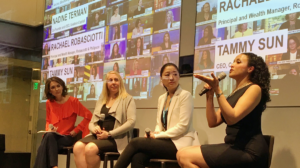Enterprises across the country are working to improve gender equality in the workplace, updating policies and programs to seek a more inclusive company culture. This has led to an increased number of advancement opportunities for women, as well as equal wages, anti-sexual harassment policies, gender balance at the board, executive, senior management and workforce levels, and improved family planning and maternity leave programs.
For media, gender equality is tied to ensuring more females are interviewed as subject matter experts. Per the Global Media Monitoring Report (GMMP), women represent about one quarter of people seen, heard or read about in the news overall (The study takes place every five years, the next one is due out later this year.) When you consider subject matter experts (SMEs) as sources, as of 2015, women represented just 19%.
What is the media industry doing to increase these numbers?

In early March 2020, Interprose team members attended an event on Bloomberg News New Voices Initiative
Although diversity in newsrooms has slowly improved, the study clearly shows that more can be done. Several companies have taken the lead to grow the number of female thought-leader and visionary experts being interviewed, including:
- Bloomberg’s New Voices Program: Commencing in 2018, the program is designed to increase gender equality among expert interviewees on television, podcasts, radio, print and digital platforms. The program helps identify females involved in business and finance, adding them to its database for current or future interviews. It also provides media training to a select number of women per year. To date, the number of women on Bloomberg TV has more than doubled since 2018 to about 22%.
- The BBC’s 50:50 Project: Created in 2017, the project aims to increase women’s representation in BBC content. Currently over 500 teams track the number of male and female contributors in their programs and make decisions based on that information with the goal of eventually achieving a 50:50 percentage.
- In 2018 and 2019 The New York Times wrote several articles noting the lack of females submitting Letters to the Editor and suggestions on how to get more women’s voices in the media. Calling attention to these issues and offering solutions is a model that publications should consider emulating.
Programs such as these are affecting positive change both inside and outside the newsroom. Diversity can help ensure broadcasters remain relevant to viewers, while simultaneously promoting a culture that celebrates differences by sourcing more female experts.
What can journalists themselves do?
- Use data. Collect data or take notes on the percentage of female sources that appear in your articles, and work to adjust them accordingly if the numbers are low.
 Seek new sources. More and more websites and databases are being created that contain lists of female experts in varying fields. These are a great start to finding a female expert that might make a good fit for your article. Here are a few examples:
Seek new sources. More and more websites and databases are being created that contain lists of female experts in varying fields. These are a great start to finding a female expert that might make a good fit for your article. Here are a few examples:- 500 Women Scientists | A resource for journalists, educators, policy makers, scientists, and anyone needing scientific expertise.
- Sourcelist | A database of female experts from diverse backgrounds on technology policy.
- Women’s Media Center | An online database of media-experienced women experts who are connected to journalists, bookers and producers.
- Ask! PR organizations are a great source for finding female SMEs. In addition to that, they can help you set up the interview and ensure that all goes smoothly.
What can businesses do?
Business leaders tend to put forth spokespeople for news stories, and should prioritize that women are aptly included. A few simple considerations can help increase female representation in the media, such as:
- Expanding your glossary of spokespeople. Not only C-level and upper-level management should be considered SMEs. Companies are full of experts, for TV, radio and podcast interviews, conference speaking sessions, guest article contributions, opinion pieces and even press release quotes;
- Offering media training to new subject matter experts. This will set your new spokespeople up for success and help drive awareness and interest in your company;
- Making it easier for journalists to find your subject matter experts. Be sure to add your spokesperson’s expertise and media training experience to their LinkedIn page, on your company bio page and into appropriate public databases;
- Creating a media diversity plan and communicate your intentions internally. Announce your plan to seek a wider range of diverse experts for the media, tracking new experts and providing regular updates in order to create excitement and instill a positive company culture.
What can PR professionals help you accomplish?
With a team of dedicated PR professionals, companies such as Interprose, are uniquely positioned to help cultivate enhanced relationships with journalists and other members of the media, clearly communicating our clients’ activities and delivering on their messaging. This includes:
- Encouraging clients to create or participate in programs similar to those described above and establishing a list of diverse resources.
- Acting as a liaison between reporters and company spokespeople, helping source more female interviewees by knowing who they are, their area of expertise and availability.
- Offering media training for new experts. Media training is a specialized form of communications training to help spokespeople remain relaxed in front of a camera and confidently focused on their messaging to become conversationalists and communicate easy-to-understand points on often-times complex subjects. Once properly media trained, female experts will be much better prepared and much more apt to shine.
The goal of increasing female representation cited as experts in the media is an important one.
Whether a broadcaster, journalist, business leader or a PR professional, organizations should continue to think critically about who is to be interviewed and the value proposition they bring to the media industry.

